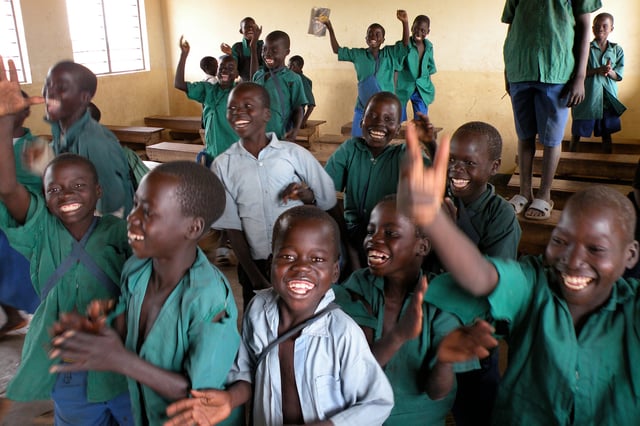Uganda
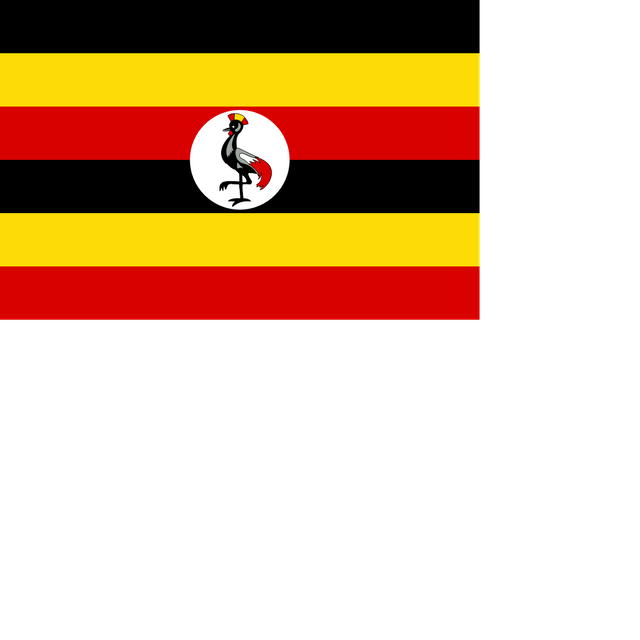
Uganda

| Capital | Kampala |
|---|---|
| Official languages | EnglishSwahili[2] |
| Demonym(s) | Ugandan[3] |
| Government | Unitarydominant-partypresidential republic |
| Yoweri Museveni | |
| Edward Ssekandi | |
| Ruhakana Rugunda | |
| Legislature | Parliament |
| Independence | |
| 9 October 1962 | |
| 8 October 1995 | |
| Area | |
| 241,038 km (93,065 sq mi) (79th) | |
| 15.39 | |
| Population | |
| 41,487,965[4](35th) | |
| 34,634,650[5] | |
| 157.1/km (406.9/sq mi) | |
| GDP | 2019 estimate |
| $102.659 billion[6] | |
| $2,566[6] | |
| GDP | 2019 estimate |
| $30.765 billion[6] | |
| $769[6] | |
| Gini | |
| HDI | |
| Currency | Ugandan shilling(UGX) |
| Time zone | (EAT) |
| Driving side | left |
| Calling code | +256 |
| ISO 3166 code | UG |
| Internet TLD | .ug |
Uganda, officially the Republic of Uganda (Swahili: Jamhuri ya Uganda),[1] is a country in East-Central Africa. It is bordered to the east by Kenya, to the north by South Sudan, to the west by the Democratic Republic of the Congo, to the south-west by Rwanda, and to the south by Tanzania. The southern part of the country includes a substantial portion of Lake Victoria, shared with Kenya and Tanzania. Uganda is in the African Great Lakes region. Uganda also lies within the Nile basin, and has a varied but generally a modified equatorial climate.
Uganda takes its name from the Buganda kingdom, which encompasses a large portion of the south of the country, including the capital Kampala. The people of Uganda were hunter-gatherers until 1,700 to 2,300 years ago, when Bantu-speaking populations migrated to the southern parts of the country.
Beginning in 1894, the area was ruled as a protectorate by the UK, who established administrative law across the territory.
Uganda gained independence from the UK on 9 October 1962.
The period since then has been marked by violent conflicts, including an 8-year-long far right military dictatorship led by officer Idi Amin. Additionally, a lengthy civil war against the Lord's Resistance Army in the Northern Region led by Joseph Kony, has caused hundreds of thousands of casualties.[9]
The official languages are English and Swahili, although "any other language may be used as a medium of instruction in schools or other educational institutions or for legislative, administrative or judicial purposes as may be prescribed by law."[2][10] Luganda, a central language, is widely spoken across the country, and several other languages are also spoken including Runyoro, Runyankole, Rukiga, Luo[3] and Lusoga.
The current president of Uganda is Yoweri Kaguta Museveni, who came to power in January 1986 after a protracted six-year guerrilla war. He has since eliminated the presidential term limits and the presidential age limit; due to the nature of Ugandan politics, this effectively makes him president for life.[11]
| Capital | Kampala |
|---|---|
| Official languages | EnglishSwahili[2] |
| Demonym(s) | Ugandan[3] |
| Government | Unitarydominant-partypresidential republic |
| Yoweri Museveni | |
| Edward Ssekandi | |
| Ruhakana Rugunda | |
| Legislature | Parliament |
| Independence | |
| 9 October 1962 | |
| 8 October 1995 | |
| Area | |
| 241,038 km (93,065 sq mi) (79th) | |
| 15.39 | |
| Population | |
| 41,487,965[4](35th) | |
| 34,634,650[5] | |
| 157.1/km (406.9/sq mi) | |
| GDP | 2019 estimate |
| $102.659 billion[6] | |
| $2,566[6] | |
| GDP | 2019 estimate |
| $30.765 billion[6] | |
| $769[6] | |
| Gini | |
| HDI | |
| Currency | Ugandan shilling(UGX) |
| Time zone | (EAT) |
| Driving side | left |
| Calling code | +256 |
| ISO 3166 code | UG |
| Internet TLD | .ug |
History

Flag of the Uganda Protectorate
Some Luo invaded the area of Bunyoro and assimilated with the Bantu there, establishing the Babiito dynasty of the current Omukama (ruler) of Bunyoro-Kitara.[16]
Arab traders moved inland from the Indian Ocean coast of East Africa in the 1830s. They were followed in the 1860s by British explorers searching for the source of the Nile.[17] British Anglican missionaries arrived in the kingdom of Buganda in 1877 (a situation which gave rise to the death of the Uganda Martyrs) and were followed by French Catholic missionaries in 1879.[18] The British government chartered the Imperial British East Africa Company (IBEAC) to negotiate trade agreements in the region beginning in 1888.[19] From 1886, there were a series of religious wars in Buganda, initially between Muslims and Christians and then, from 1890, between ba-Ingleza Protestants and ba-Fransa Catholics.[20] Because of civil unrest and financial burdens, IBEAC claimed that it was unable to "maintain their occupation" in the region.[21] British commercial interests were ardent to protect the trade route of the Nile, which prompted the British government to annex Buganda and adjoining territories to create the Uganda Protectorate in 1894.[19]
Uganda Protectorate (1894–1962)
In the 1890s, 32,000 labourers from British India were recruited to East Africa under indentured labour contracts to construct the Uganda Railway.[22] Most of the surviving Indians returned home, but 6,724 decided to remain in East Africa after the line's completion.[23] Subsequently, some became traders and took control of cotton ginning and sartorial retail.[24]
From 1900 to 1920, a sleeping sickness epidemic in the southern part of Uganda, along the north shores of Lake Victoria, killed more than 250,000 people.[25]
Independence (1962 to 1965)
Uganda gained independence from the UK on 9 October 1962 with Queen Elizabeth II as head of state and Queen of Uganda. In October 1963, Uganda became a republic but maintained its membership in the Commonwealth of Nations.
The first post-independence election, held in 1962, was won by an alliance between the Uganda People's Congress (UPC) and Kabaka Yekka (KY). UPC and KY formed the first post-independence government with Milton Obote as executive prime minister, with the Buganda Kabaka (King) Edward Muteesa II holding the largely ceremonial position of president.[26][27]
Buganda crisis (1962–1966)
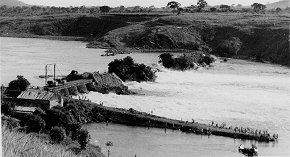
Construction of the Owen Falls Dam in Jinja.

The Uganda printers building on Kampala Road, Kampala, Uganda
Uganda's immediate post-independence years were dominated by the relationship between the central government and the largest regional kingdom – Buganda.[28]
From the moment the British created the Uganda protectorate, the issue of how to manage the largest monarchy within the framework of a unitary state had always been a problem.
Colonial governors had failed to come up with a formula that worked.
This was further complicated by Buganda's nonchalant attitude to its relationship with the central government.
Buganda never sought independence, but rather appeared to be comfortable with a loose arrangement that guaranteed them privileges above the other subjects within the protectorate or a special status when the British left.
This was evidenced in part by hostilities between the British colonial authorities and Buganda prior to independence.[29]
Within Buganda there were divisions – between those who wanted the Kabaka to remain a dominant monarch, and those who wanted to join with the rest of Uganda to create a modern secular state. The split resulted in the creation of two dominant Buganda based parties – the Kabaka Yekka (Kabaka Only) KY, and the Democratic Party (DP) that had roots in the Catholic Church. The bitterness between these two parties was extremely intense especially as the first elections for the post-Colonial parliament approached. The Kabaka particularly disliked the DP leader, Benedicto Kiwanuka.[30]
Outside Buganda, a quiet spoken politician from Northern Uganda, Milton Obote, had forged an alliance of non-Buganda politicians to form the Uganda People's Congress (UPC). The UPC at its heart was dominated by politicians who wanted to rectify what they saw as the regional inequality that favoured Buganda's special status. This drew in substantial support from outside Buganda. The party however remained a loose alliance of interests but Obote showed great skill at negotiating them into a common ground based on a federal formula.[31]
At Independence, the Buganda question remained unresolved.
Uganda was one of the few colonial territories that achieved independence without a dominant political party with a clear majority in parliament.
In the pre-Independence elections, the UPC ran no candidates in Buganda and won 37 of the 61 directly elected seats (outside Buganda).
The DP won 24 seats outside Buganda.
The "special status" granted to Buganda meant that the 21 Buganda seats were elected by proportional representation reflecting the elections to the Buganda parliament – the Lukikko.
KY won a resounding victory over DP, winning all 21 seats.
The UPC reached a high at the end of 1964 when the leader of the DP in parliament, Basil Kiiza Bataringaya crossed the parliamentary floor with five other MPs, leaving DP with only nine seats. The DP MPs were not particularly happy that their leader Benedicto Kiwanuka's hostility towards the Kabaka that was hindering their chances of compromise with KY.[32] The trickle of defections turned into a flood when 10 KY members crossed the floor when they realised the formal coalition with the UPC was no longer viable. Obote's charismatic speeches across the country were sweeping all before him, and the UPC was winning almost every local election held and increasing its control over all district councils and legislatures outside Buganda.[33] The response from the Kabaka was mute – probably content in his ceremonial role and symbolism in his part of the country. However, there were also major divisions within his palace that made it difficult for him to act effectively against Obote. By the time Uganda had become independent, Buganda "was a divided house with contending social and political forces"[34] There were however problems brewing inside the UPC.
As its ranks swelled, the ethnic, religious, regional and personal interests began to shake the party.
The party's apparent strength was eroded in a complex sequence of factional conflicts in its central and regional structures.
And by 1966, the UPC was tearing itself apart.
The conflicts were further intensified by the newcomers who had crossed the parliamentary floor from DP and KY.[34]
The UPC delegates arrived in Gulu in 1964 for their delegates conference. Here was the first demonstration as to how Obote was losing control of his party. The battle over the Secretary General of the party was a bitter contest between the new moderate's candidate – Grace Ibingira and the radical John Kakonge. Ibingira subsequently became the symbol of the opposition to Obote within the UPC. This is an important factor when looking at the subsequent events that led to the crisis between Buganda and the Central government. For those outside the UPC (including KY supporters), this was a sign that Obote was vulnerable. Keen observers realised the UPC was not a cohesive unit.[34]
The collapse of the UPC-KY alliance openly revealed the dissatisfaction Obote and others had about Buganda's "special status".
In 1964 The government responded to demands from some parts of the vast Buganda Kingdom that they were not the Kabaka's subjects.
Prior to colonial rule Buganda had been rivalled by the neighbouring Bunyoro kingdom. Buganda had conquered parts of Bunyoro and the British colonialists had formalised this in the Buganda Agreements. Known as the "lost counties", the people in these areas wished to revert to being part of Bunyoro. Obote decided to allow a referendum, which angered the Kabaka and most of the rest of Buganda. The residents of the counties voted to return to Bunyoro despite the Kabaka's attempts to influence the vote.[37] Having lost the referendum, KY opposed the bill to pass the counties to Bunyoro, thus ending the alliance with the UPC.
The tribal nature of Ugandan politics was also manifesting itself in government.
The UPC which had previously been a national party began to break along tribal lines when Ibingira challenged Obote in the UPC.
The "North/South" ethnic divide that had been evident in economic and social spheres now entrenched itself in politics.
Obote surrounded himself with mainly northern politicians – A. A. Neykon, Felix Onama, Alex Ojera – while Ibingira's supporters who were subsequently arrested and jailed with him, were mainly from the South – George Magezi, B. Kirya, Matthias Ngobi.
In time, the two factions acquired ethnic labels – "Bantu" (the mainly Southern Ibingira faction) and "Nilotic" (the mainly Northern Obote faction).
The perception that the government was at war with the Bantu was further enhanced when Obote arrested and imprisoned the mainly Bantu ministers who backed Ibingira.[38]
These labels brought into the mix two very powerful influences.
First Buganda – the people of Buganda are Bantu and therefore naturally aligned to the Ibingira faction.
The Ibingira faction further advanced this alliance by accusing Obote of wanting to overthrow the Kabaka.[38] They were now aligned to opposing Obote. Second – the security forces – the British colonialists had recruited the army and police almost exclusively from Northern Uganda due to their perceived suitability for these roles. At independence, the army and police was dominated by northern tribes – mainly Nilotic. They would now feel more affiliated to Obote, and he took full advantage of this to consolidate his power. In April 1966, Obote passed out eight hundred new army recruits at Moroto, of whom seventy percent came from the Northern Region.[34]
It is true that at the time there was a tendency to see central government and security forces as dominated by "northerners" – particularly the Acholi who through the UPC had significant access to government positions at national level.[40] In northern Uganda there were also varied degrees of anti-Buganda feelings, particularly over the kingdom's "special status" before and after independence, and all the economic and social benefits that came with this status. "Obote brought significant numbers of northerners into the central state, both through the civil service and military, and created a patronage machine in Northern Uganda".[40] However, both "Bantu" and "Nilotic" labels represent significant ambiguities. The Bantu category for example includes both Buganda and Bunyoro – historically bitter rivals. The Nilotic label includes the Lugbara, Acholi and Langi who have bitter rivalries that were to define Uganda's military politics later. Despite these ambiguities, these events unwittingly brought to fore the northerner/southerner political divide which to some extent still influences Ugandan politics.
The UPC fragmentation continued as opponents sensed Obote's vulnerability.
At local level where the UPC dominated most councils discontent began to challenge incumbent council leaders.
Even in Obote's home district, attempts were made to oust the head of the local district council in 1966.
A more worrying fact for the UPC was that the next national elections loomed in 1967 – and without the support of KY (who were now likely to back the DP), and the growing factionalism in the UPC, there was the real possibility that the UPC would be out of power in months.
Obote went after KY with a new act of parliament in early 1966 that blocked any attempt by KY to expand outside Buganda.
KY appeared to respond in parliament through one of their few remaining MPs, the terminally ill Daudi Ochieng.
Ochieng was an irony – although from Northern Uganda, he had risen high in the ranks of KY and become a close confidant to the Kabaka who had gifted him with large land titles in Buganda.
In Obote's absence from Parliament, Ochieng laid bare the illegal plundering of ivory and gold from the Congo that had been orchestrated by Obote's army chief of staff, Colonel Idi Amin. He further alleged that Obote, Onama and Neykon had all benefited from the scheme.[41] Parliament overwhelmingly voted in favour of a motion to censure Amin and investigate Obote's involvement. This shook the government and raised tensions in the country.
KY further demonstrated its ability to challenge Obote from within his party at the UPC Buganda conference where Godfrey Binaisa (the Attorney General) was ousted by a faction believed to have the backing of KY, Ibingira and other anti-Obote elements in Buganda.[34] Obote's response was to arrest Ibingira and other ministers at a cabinet meeting and to assume special powers in February 1966. In March 1966, Obote also announced that the offices of President and Vice President would cease to exist – effectively dismissing the Kabaka. Obote also gave Amin more power – giving him the Army Commander position over the previous holder (Opolot) who had relations to Buganda through marriage (possibly believing Opolot would be reluctant to take military action against the Kabaka if it came to that). Obote abolished the constitution and effectively suspended elections due in a few months. Obote went on television and radio to accuse the Kabaka of various offences including requesting foreign troops which appears to have been explored by the Kabaka following the rumours of Amin plotting a coup. Obote further dismantled the authority of the Kabaka by announcing among other measures:
The abolition of independent public service commissions for federal units.
This removed the Kabaka's authority to appoint civil servants in Buganda.
The abolition of the Buganda High Court – removing any judicial authority the Kabaka had.
The bringing of Buganda financial management under further central control.
Abolition of lands for Buganda chiefs.
Land is one the key sources of Kabaka's power over his subjects.
The lines were now drawn for a show down between Buganda and the Central government.
Historians may argue about whether this could have been avoided through compromise.
This was unlikely as Obote now felt emboldened and saw the Kabaka as weak.
Indeed, by accepting the presidency four years earlier and siding with the UPC, the Kabaka had divided his people and taken the side of one against the other.
Within Buganda's political institutions, rivalries driven by religion and personal ambition made the institutions ineffective and unable to respond to the central government moves.
The Kabaka was often regarded as aloof and unresponsive to advice from the younger Buganda politicians who better understood the new post-Independence politics, unlike the traditionalists who were ambivalent to what was going on as long as their traditional benefits were maintained.
The Kabaka favoured the neo-traditionalists.[34]
In May 1966, the Kabaka made his move.
He asked for foreign help and the Buganda parliament demanded that the Uganda government leave Buganda (including the capital, Kampala).
In response Obote ordered Idi Amin to attack the Kabaka's palace.
The battle for the Kabaka's palace was fierce – the Kabaka's guards putting up more resistance that had been expected.
The British trained Captain – the Kabaka with about 120 armed men kept Idi Amin at bay for twelve hours.[34] It is estimated that up to 2,000 people died in the battle which ended when the army called in heavier guns and overran the palace. The anticipated countryside uprising in Buganda did not materialise and a few hours later a beaming Obote met the press to relish his victory. The Kabaka escaped over the palace walls and was scuttled off into exile in London by supporters. He died there three years later.
1966–1971 (before the coup)
In 1966, following a power struggle between the Obote-led government and King Muteesa, Obote suspended the constitution and removed the ceremonial president and vice-president.
In 1967, a new constitution proclaimed Uganda a republic and abolished the traditional kingdoms.
Obote was declared the president.[18]
1971 (after the coup) –1979 (end of Amin regime)
After a military coup on 25 January 1971, Obote was deposed from power and General Idi Amin seized control of the country. Amin ruled Uganda as dictator with the support of the military for the next eight years.[44] He carried out mass killings within the country to maintain his rule. An estimated 80,000–500,000 Ugandans lost their lives during his regime.[45] Aside from his brutalities, he forcibly removed the entrepreneurial Indian minority from Uganda. [46] In June 1976, Palestinian terrorists hijacked an Air France flight and forced it to land at Entebbe airport. One hundred of the 250 passengers originally on board were held hostage until an Israeli commando raid rescued them ten days later.[47] Amin's reign was ended after the Uganda-Tanzania War in 1979, in which Tanzanian forces aided by Ugandan exiles invaded Uganda.
1979–present

Belligerents of the Second Congo War.
Yoweri Museveni has been president since his forces toppled the previous regime in January 1986.
Political parties in Uganda were restricted in their activities beginning that year, in a measure ostensibly designed to reduce sectarian violence. In the non-party "Movement" system instituted by Museveni, political parties continued to exist, but they could operate only a headquarters office. They could not open branches, hold rallies, or field candidates directly (although electoral candidates could belong to political parties). A constitutional referendum cancelled this nineteen-year ban on multi-party politics in July 2005.
In the mid-to-late 1990s, Museveni was lauded by western countries as part of a new generation of African leaders.[49]
His presidency has been marred, however, by invading and occupying the Democratic Republic of the Congo during the Second Congo War, resulting in an estimated 5.4 million deaths since 1998, and by participating in other conflicts in the Great Lakes region of Africa. He has struggled for years in the civil war against the Lord's Resistance Army, which has been guilty of numerous crimes against humanity, including child slavery, the Atiak massacre, and other mass murders. Conflict in northern Uganda has killed thousands and displaced millions.[50]
Parliament abolished presidential term limits in 2005, allegedly because Museveni used public funds to pay US$2,000 to each member of parliament who supported the measure.[51] Presidential elections were held in February 2006.
Museveni ran against several candidates, the most prominent of them being Kizza Besigye.
On 20 February 2011, the Uganda Electoral Commission declared the incumbent president Yoweri Kaguta Museveni the winning candidate of the 2011 elections that were held on 18 February 2011.
The opposition however, were not satisfied with the results, condemning them as full of sham and rigging.
According to the official results, Museveni won with 68 percent of the votes.
This easily topped his nearest challenger, Besigye, who had been Museveni's physician and told reporters that he and his supporters "downrightly snub" the outcome as well as the unremitting rule of Museveni or any person he may appoint.
Besigye added that the rigged elections would definitely lead to an illegitimate leadership and that it is up to Ugandans to critically analyse this.
The European Union's Election Observation Mission reported on improvements and flaws of the Ugandan electoral process: "The electoral campaign and polling day were conducted in a peaceful manner [...] However, the electoral process was marred by avoidable administrative and logistical failures that led to an unacceptable number of Ugandan citizens being disfranchised."[52]
Geography
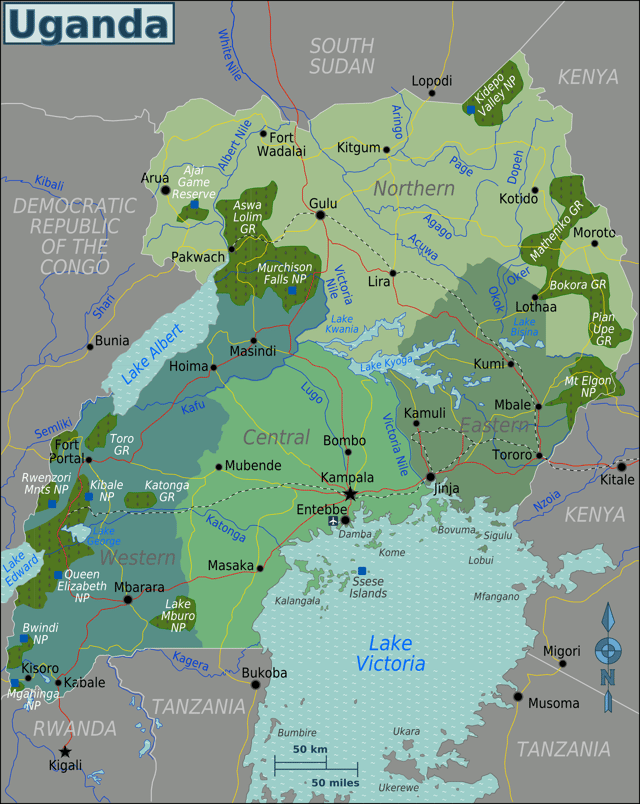
Regional map of Uganda.
The country is located on the East African Plateau, lying mostly between latitudes 4°N and 2°S (a small area is north of 4°), and longitudes 29° and 35°E. It averages about 1,100 metres (3,609 ft) above sea level, sloping very steadily downwards to the Sudanese Plain to the north. Some international trade organizations categorize Kenya as part of the Greater Horn of Africa[59]
Lakes and rivers
Much of the south of the country is heavily influenced by one of the world's biggest lakes, Lake Victoria, which contains many islands.
Most important cities are located in the south, near this lake, including the capital Kampala and the nearby city of Entebbe.[60]
Lake Kyoga is in the centre of the country and is surrounded by extensive marshy areas.[61]
Although landlocked, Uganda contains many large lakes.
Besides Lakes Victoria and Kyoga, there are Lake Albert, Lake Edward, and the smaller Lake George.[60]
Uganda lies almost completely within the Nile basin. The Victoria Nile drains from Lake Victoria into Lake Kyoga and thence into Lake Albert on the Congolese border. It then runs northwards into South Sudan. An area in eastern Uganda is drained by the Suam River, part of the internal drainage basin of Lake Turkana. The extreme north-eastern part of Uganda drains into the Lotikipi Basin, which is primarily in Kenya.[60]
Environment and conservation

Uganda map of Köppen climate classification.
Uganda has 60 protected areas, including ten national parks: Bwindi Impenetrable National Park and Rwenzori Mountains National Park (both UNESCO World Heritage Sites[62]), Kibale National Park, Kidepo Valley National Park, Lake Mburo National Park, Mgahinga Gorilla National Park, Mount Elgon National Park, Murchison Falls National Park, Queen Elizabeth National Park, and Semuliki National Park.
Government and politics
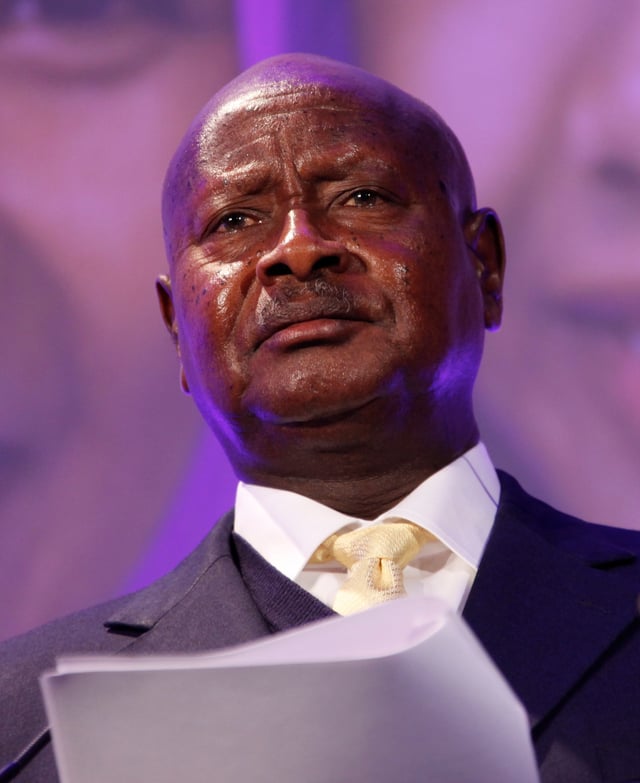
Yoweri Museveni, President of Uganda since 1986
The President of Uganda is both head of state and head of government. The president appoints a vice-president and a prime minister to aid him in governing.
The parliament is formed by the National Assembly, which has 449 members. These include; 290 constituency representatives, 116 district woman representatives, 10 representatives of the Uganda Peoples Defence Forces, 5 representatives of the youth, 5 representatives of workers, 5 representatives of persons with disabilities and 18 ex-official members.
Corruption
Transparency International has rated Uganda's public sector as one of the most corrupt in the world. In 2016, Uganda ranked 151st worst out of 176 and had a score of 25 on a scale from 0 (perceived as most corrupt) to 100 (perceived as clean).[63]
The World Bank's 2015 Worldwide Governance Indicators ranked Uganda in the worst 12 percentile of all countries.[64] According to the United States Department of State's 2012 Human Rights Report on Uganda, "The World Bank's most recent Worldwide Governance Indicators reflected corruption was a severe problem" and that "the country annually loses 768.9 billion shillings ($286 million) to corruption."[57]
Ugandan parliamentarians in 2014 earned 60 times what was earned by most state employees, and they sought a major increase.
This caused widespread criticism and protests, including the smuggling of two piglets into the parliament in June 2014 to highlight corruption amongst members of parliament.
The protesters, who were arrested, used the word "MPigs" to highlight their grievance.[65]
A specific scandal, which had significant international consequences and highlighted the presence of corruption in high-level government offices, was the embezzlement of $12.6 million of donor funds from the Office of the Prime Minister in 2012.
These funds were "earmarked as crucial support for rebuilding northern Uganda, ravaged by a 20-year war, and Karamoja, Uganda's poorest region."
This scandal prompted the EU, the UK, Germany, Denmark, Ireland, and Norway to suspend aid.[66]
Widespread grand and petty corruption involving public officials and political patronage systems have also seriously affected the investment climate in Uganda.
One of the high corruption risk areas is the public procurement in which non-transparent under-the-table cash payments are often demanded from procurement officers.[67]
What may ultimately compound this problem is the availability of oil.
The Petroleum Bill, passed by parliament in 2012 and touted by the NRM as bringing transparency to the oil sector, has failed to please domestic and international political commentators and economists.
For instance, Angelo Izama, a Ugandan energy analyst at the US-based Open Society Foundation said the new law was tantamount to "handing over an ATM (cash) machine" to Museveni and his regime.[68] According to Global Witness in 2012, a non-governmental organization devoted to international law, Uganda now has "oil reserves that have the potential to double the government's revenue within six to ten years, worth an estimated US $2.4 billion per year."[69]
The Non-Governmental Organizations (Amendment) Act, passed in 2006, has stifled the productivity of NGOs through erecting barriers to entry, activity, funding and assembly within the sector.
Burdensome and corrupt registration procedures (i.e. requiring recommendations from government officials; annual re-registration), unreasonable regulation of operations (i.e. requiring government notification prior to making contact with individuals in NGO's area of interest), and the precondition that all foreign funds be passed through the Bank of Uganda, among other things, are severely limiting the output of the NGO sector.
Furthermore, the sector's freedom of speech has been continually infringed upon through the use of intimidation, and the recent Public Order Management Bill (severely limiting freedom of assembly) will only add to the government's stockpile of ammunition.[70]
Administrative divisions
Political subdivisions in Uganda are officially served and united by the Uganda Local Governments Association (ULGA), a voluntary and non-profit body which also serves as a forum for support and guidance for Ugandan sub-national governments.[74]
Parallel with the state administration, five traditional Bantu kingdoms have remained, enjoying some degrees of mainly cultural autonomy. The kingdoms are Toro, Busoga, Bunyoro, Buganda, and Rwenzururu. Furthermore, some groups attempt to restore Ankole as one of the officially recognised traditional kingdoms, to no avail yet.[75] Several other kingdoms and chiefdoms are officially recognized by the government, including the union of Alur chiefdoms, the Iteso paramount chieftaincy, the paramount chieftaincy of Lango and the Padhola state.[76]
Foreign relations and military

U.S. President George W. Bush met with President Yoweri Museveni in Entebbe, Uganda, July 11, 2003.
In Uganda, the Uganda People's Defence Force serves as the military. The number of military personnel in Uganda is estimated at 45,000 soldiers on active duty. The Uganda army is involved in several peacekeeping and combat missions in the region, with commentators noting that only the United States Armed Forces is deployed in more countries. Uganda has soldiers deployed in the northern and eastern areas of the Democratic Republic of the Congo and in the Central African Republic, Somalia, and South Sudan.[77] Uganda is also a member of the Organization of Islamic Cooperation.[78]
Human rights
There are many areas which continue to attract concern when it comes to human rights in Uganda.
Conflict in the northern parts of the country continues to generate reports of abuses by both the rebel Lord's Resistance Army (LRA), led by Joseph Kony, and the Ugandan Army. A UN official accused the LRA in February 2009 of "appalling brutality" in the Democratic Republic of Congo.[79]
The number of internally displaced persons is estimated at 1.4 million. Torture continues to be a widespread practice amongst security organisations. Attacks on political freedom in the country, including the arrest and beating of opposition members of parliament, have led to international criticism, culminating in May 2005 in a decision by the British government to withhold part of its aid to the country. The arrest of the main opposition leader Kizza Besigye and the siege of the High Court during a hearing of Besigye's case by heavily armed security forces – before the February 2006 elections – led to condemnation.[80]
Child labour is common in Uganda. Many child workers are active in agriculture.[81] Children who work on tobacco farms in Uganda are exposed to health hazards.[81] Child domestic servants in Uganda risk sexual abuse.[81] Trafficking of children occurs.[81] Slavery and forced labour are prohibited by the Ugandan constitution.[81]
The US Committee for Refugees and Immigrants reported several violations of refugee rights in 2007, including forcible deportations by the Ugandan government and violence directed against refugees.[82]
Torture and extrajudicial killings have been a pervasive problem in Uganda in recent years.
For instance, according to a 2012 US State Department report, "the African Center for Treatment and Rehabilitation for Torture Victims registered 170 allegations of torture against police, 214 against the UPDF, 1 against military police, 23 against the Special Investigations Unit, 361 against unspecified security personnel, and 24 against prison officials" between January and September 2012.[57]
In September 2009 Museveni refused Kabaka Muwenda Mutebi, the Baganda king, permission to visit some areas of Buganda Kingdom, particularly the Kayunga district.
Riots occurred and over 40 people were killed while others remain imprisoned to this date.
Furthermore, 9 more people were killed during the April 2011 "Walk to Work" demonstrations.
According to the Humans Rights Watch 2013 World Report on Uganda, the government has failed to investigate the killings associated with both of these events.[83]
LGBT rights
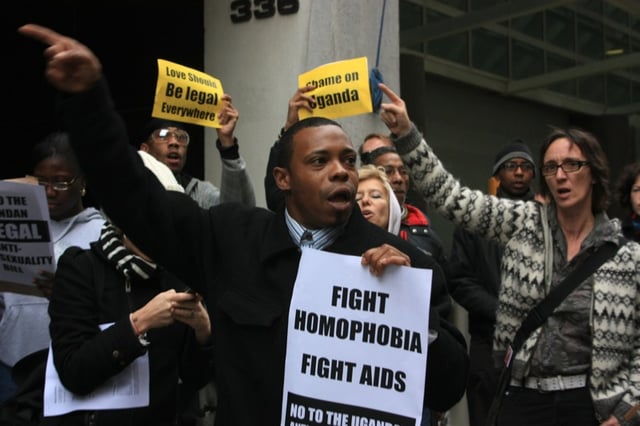
Protests in New York City against Uganda's Anti-Homosexuality Bill.
In 2007, a Ugandan newspaper, the Red Pepper, published a list of allegedly gay men, many of whom suffered harassment as a result.[84]
On 9 October 2010, the Ugandan newspaper Rolling Stone published a front-page article titled "100 Pictures of Uganda's Top Homos Leak" that listed the names, addresses, and photographs of 100 homosexuals alongside a yellow banner that read "Hang Them".[85] The paper also alleged that homosexuals aimed to recruit Ugandan children. This publication attracted international attention and criticism from human rights organisations, such as Amnesty International,[86] No Peace Without Justice[87] and the International Lesbian, Gay, Bisexual, Trans and Intersex Association.[88] According to gay rights activists, many Ugandans have been attacked since the publication.[89] On 27 January 2011, gay rights activist David Kato was murdered.[90]
In 2009, the Ugandan parliament considered an Anti-Homosexuality Bill that would have broadened the criminalisation of homosexuality by introducing the death penalty for people who have previous convictions, or are HIV-positive, and engage in same-sex sexual acts. The bill also included provisions for Ugandans who engage in same-sex sexual relations outside of Uganda, asserting that they may be extradited back to Uganda for punishment, and included penalties for individuals, companies, media organisations, or non-governmental organisations that support legal protection for homosexuality or sodomy. The private member's bill was submitted by MP David Bahati in Uganda on 14 October 2009, and was believed to have had widespread support in the Uganda parliament.[91] The hacktivist group Anonymous hacked into Ugandan government websites in protest of the bill.[92] The debate of the bill was delayed in response to global condemnation but was eventually passed on 20 December 2013 and signed by President Yoweri Museveni on 24 February 2014. The death penalty was dropped in the final legislation. The law was widely condemned by the international community. Denmark, the Netherlands, and Sweden said they would withhold aid. The World Bank on 28 February 2014 said it would postpone a US$90 million loan, while the United States said it was reviewing ties with Uganda.[93] On 1 August 2014, the Constitutional Court of Uganda ruled the bill invalid as it was not passed with the required quorum.[94][95][96] A 13 August 2014 news report said that the Ugandan attorney general had dropped all plans to appeal, per a directive from President Museveni who was concerned about foreign reaction to the bill and who also said that any newly introduced bill should not criminalize same-sex relationships between consenting adults.[97]
Economy and infrastructure
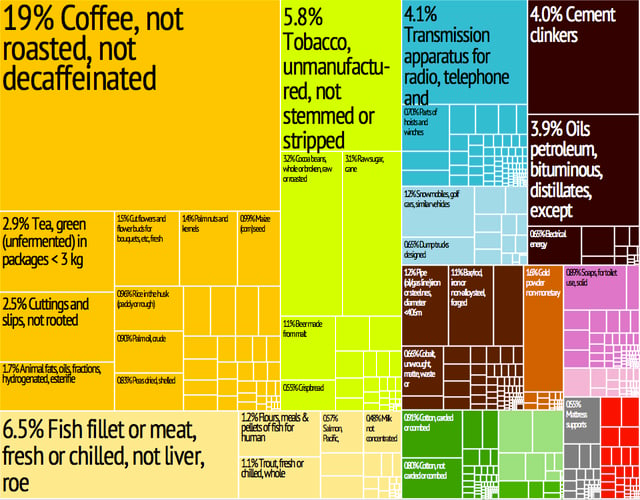
Graphical depiction of Uganda's product exports in 28 color-coded categories.
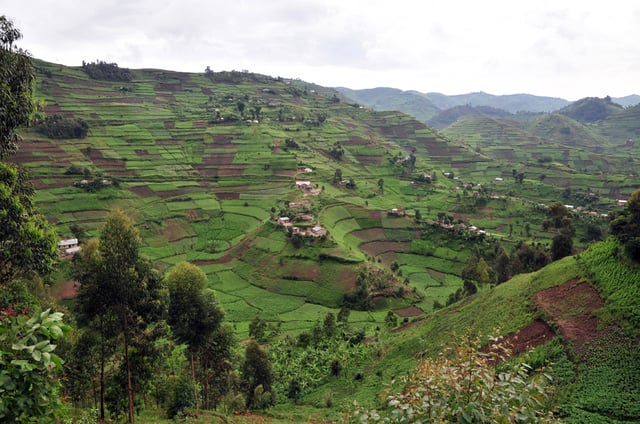
Coffee fields in southwestern Uganda
The Bank of Uganda is the central bank of Uganda and handles monetary policy along with the printing of the Ugandan shilling.[98]
In 2015, Uganda's economy generated export income from the following merchandise: coffee (US$402.63 million), oil re-exports (US$131.25 million), base metals and products (US$120.00 million), fish (US$117.56 million), maize (US$90.97 million), cement (US$80.13 million), tobacco (US$73.13 million), tea (US$69.94 million), sugar (US$66.43 million), hides and skins (US$62.71 million), cocoa beans (US$55.67 million), beans (US$53.88 million), simsim (US$52.20 million), flowers (US$51.44 million), and other products (US$766.77 million).[99]
The country has been experiencing consistent economic growth.
In fiscal year 2015–16, Uganda recorded gross domestic product growth of 4.6 percent in real terms and 11.6 percent in nominal terms.
This compares to 5.0 percent real growth in fiscal year 2014–15.[100]
The country has largely untapped reserves of both crude oil and natural gas.[101] While agriculture accounted for 56 percent of the economy in 1986, with coffee as its main export, it has now been surpassed by the services sector, which accounted for 52 percent of GDP in 2007.[102] In the 1950s, the British colonial regime encouraged some 500,000 subsistence farmers to join co-operatives.[103] Since 1986, the government (with the support of foreign countries and international agencies) has acted to rehabilitate an economy devastated during the regime of Idi Amin and the subsequent civil war.[3]
In 2012, the World Bank still listed Uganda on the Heavily Indebted Poor Countries list.[104]
Economic growth has not always led to poverty reduction. Despite an average annual growth of 2.5 percent between 2000 and 2003, poverty levels increased by 3.8 percent during that time.[105] This has highlighted the importance of avoiding jobless growth and is part of the rising awareness in development circles of the need for equitable growth not just in Uganda, but across the developing world.[105]
With the Uganda securities exchanges established in 1996, several equities have been listed.
The government has used the stock market as an avenue for privatisation.
All government treasury issues are listed on the securities exchange.
The Capital Markets Authority has licensed 18 brokers, asset managers, and investment advisors including: African Alliance Investment Bank, Baroda Capital Markets Uganda Limited, Crane Financial Services Uganda Limited, Crested Stocks and Securities Limited, Dyer & Blair Investment Bank, Equity Stock Brokers Uganda Limited, Renaissance Capital Investment Bank and UAP Financial Services Limited.[106] As one of the ways of increasing formal domestic savings, pension sector reform is the centre of attention (2007).[107][108]
Uganda traditionally depends on Kenya for access to the Indian Ocean port of Mombasa. Efforts have intensified to establish a second access route to the sea via the lakeside ports of Bukasa in Uganda and Musoma in Tanzania, connected by railway to Arusha in the Tanzanian interior and to the port of Tanga on the Indian Ocean.[109]
Uganda is a member of the East African Community and a potential member of the planned East African Federation.
Uganda has a large diaspora, residing mainly in the United States and the United Kingdom.
This diaspora has contributed enormously to Uganda's economic growth through remittances and other investments (especially property).
According to the World Bank, Uganda received in 2016 an estimated US$1.099 billion in remittances from abroad, second only to Kenya (US$1.574 billion) in the East African Community.[110] Uganda also serves as an economic hub for a number of neighbouring countries like the Democratic Republic of the Congo,[111] South Sudan,[112] and Rwanda.[113]
The Ugandan Bureau of Statistics announced inflation was 4.6 percent in November 2016.[114] On June 29, 2018, Uganda's statistics agency said the country registered a drop in inflation to 3.4 percent in the financial year ending 2017/18 compared to the 5.7 percent recorded in the financial year 2016/17.[115]
Industry
Uganda ranked as number 102 among the countries of the world in nominal Gross Domestic Product by the International Monetary Fund with a GDP of 26,349 (US$million). ranked Uganda as number 99 in nominal GDP with a GDP of 25,891 (US$million).[117] Based on the GDP with purchasing power parity the IMF ranked Uganda as number 86 (91,212 millions of current Int$) and the World Bank ranked them 90 (79,889 millions of current Int$).
Since the 1990s, the economy in Uganda is growing.
Real gross domestic product (GDP) grew at an average of 6.7% annually during the period 1990–2015, whereas real GDP per capita grew at 3.3% per annum during the same period.[118]
Poverty
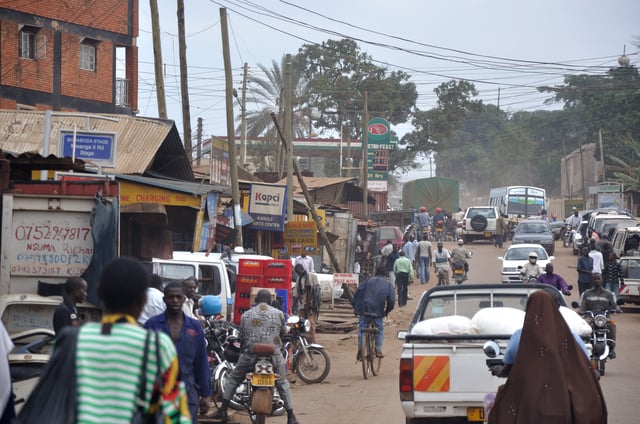
Street views in Kampala
Uganda is one of the poorest nations in the world.
In 2012, 37.8 percent of the population lived on less than $1.25 a day.[119] Despite making enormous progress in reducing the countrywide poverty incidence from 56 percent of the population in 1992 to 24.5 percent in 2009, poverty remains deep-rooted in the country's rural areas, which are home to 84 percent of Ugandans.[120]
People in rural areas of Uganda depend on farming as the main source of income and 90 per cent of all rural women work in the agricultural sector.[121] In addition to agricultural work, rural women are responsible for the caretaking of their families.
The average Ugandan woman spends 9 hours a day on domestic tasks, such as preparing food and clothing, fetching water and firewood, and caring for the elderly, the sick as well as orphans.
As such, women on average work longer hours than men, between 12 and 18 hours per day, with a mean of 15 hours, as compared to men, who work between 8 and 10 hours a day.[122]
To supplement their income, rural women may engage in small-scale entrepreneurial activities such as rearing and selling local breeds of animals.
Nonetheless, because of their heavy workload, they have little time for these income-generating activities.
The poor cannot support their children at school and in most cases, girls drop out of school to help out in domestic work or to get married.
Other girls engage in sex work.
As a result, young women tend to have older and more sexually experienced partners and this puts women at a disproportionate risk of getting affected by HIV, accounting for about 57 per cent of all adults living with HIV in Uganda.[123]
Maternal health in rural Uganda lags behind national policy targets and the Millennium Development Goals, with geographical inaccessibility, lack of transport and financial burdens identified as key demand-side constraints to accessing maternal health services;[124] as such, interventions like intermediate transport mechanisms have been adopted as a means to improve women's access to maternal health care services in rural regions of the country.[125]
Gender inequality is the main hindrance to reducing women's poverty.
Women are subjected to an overall lower social status than men.
For many women, this reduces their power to act independently, participate in community life, become educated and escape reliance upon abusive men.[126]
Air transportation
In total there are 35 airports right now in Uganda. Four airports have scheduled passenger service on commercial airlines. Uganda has an international airport, the Entebbe International Airport which is located 25 mi south-west of the capital and largest city of Uganda Kampala.[127] In 2017 the airport traffic hit 1.53 million passengers, 8% more than the previous year.[128] A second international airport, the Hoima International Airport is under construction at the moment.[129]
Road network
Road transportation is the most important way of transportation in Uganda.
95% of freight and passenger traffic is handled by road traffic.
The road network in Uganda consists out of approx.
80,448 miles (129,469 km) roads.
About 4% of these roads are paved which means about 3,293 miles (5,300 km).
The different types of roads are national roads (13,676miles – 17%), district roads (20,916miles — 26%), urban roads (5,631miles – 7%), and community roads (40,224miles – 50%).[130] The national roads make up about 17% of the road network but carry over 80% of the total road traffic.[131] In Uganda there are 83,000 private cars which means 2,94 cars per 1000 inhabitants.[132]
Railroad
The rail network in Uganda has a length of estimated 783 miles.
The longest lines are the main line from Kampala to Tororo (155 mi), the western line from Kampala to Kasese (207 mi), the northern line from Tororo to Pakwach (398 mi).[133]
Communications

An advertisement for a mobile phone carrier on a van in Kampala.
The total mobile and fixed telephony subscriptions increased from over 20 million to over 21 million yielding an increment of over 1.1 million subscribers (5.4 increase) compared to the 4.1 percent increases realized in the previous quarter Q4 2014 (October–December).[134]
| Indicators | Q4 2014 | Q1 2015 | Change (%) |
|---|---|---|---|
| Mobile Subscriptions (prepaid) | 20,257,656 | 21,347,079 | 5.4 |
| Mobile Subscriptions (post-paid) | 108,285 | 110,282 | 1.8 |
| Fixed subscriptions | 324,442 | 349,163 | 7.6 |
| Tele-density | 56.5 | 62.5 | 10.6 |
| National status | 20,690,383 | 21,806,523 | 5.4 |
Energy
In the 1980s, the majority of energy in Uganda came from charcoal and wood.
However, oil was found in the Lake Albert area, totaling an estimated 95,000,000 m3 (3.354893339×109 cu ft) barrels of crude.[101] Heritage Oil discovered one of the largest crude oil finds in Uganda, and continues operations there.[137]
Water supply and sanitation
According to a 2006 published report, the Ugandan water supply and sanitation sector had made substantial progress in urban areas since the mid-1990s, with substantial increases in coverage as well as in operational and commercial performance.[138] Sector reforms in the period 1998–2003 included the commercialization and modernization of the National Water and Sewerage Corporation operating in cities and larger towns, as well as decentralization and private sector participation in small towns.[139]
Although these reforms have attracted significant international attention, 38 percent of the population still had no access to an improved water source in 2010. Concerning access to improved sanitation, figures have varied widely. According to government figures, it was 70 percent in rural areas and 81 percent in urban areas in 2011,[140] while according to UN figures it was only 34 percent.[141]
The water and sanitation sector was recognized as a key area under the 2004 Poverty Eradication Action Plan (PEAP), Uganda's main strategy paper to fight poverty.[142] According to a 2006 published report, a comprehensive expenditure framework had been introduced to coordinate financial support by external donors, the national government, and nongovernmental organizations.[143] The PEAP estimated that from 2001 to 2015, about US$1.4 billion, or US$92 million per year, was needed to increase water supply coverage up to 95 percent, with rural areas needing US$956 million, urban areas and large towns needing US$281 million, and small towns needing US$136 million.[142]
Education
Health
Health system. There were eight physicians per 100,000 persons in the early 2000s.[144] Uganda's elimination of user fees at state health facilities in 2001 has resulted in an 80 percent increase in visits, with over half of this increase coming from the poorest 20 percent of the population.[145] This policy has been cited as a key factor in helping Uganda achieve its Millennium Development Goals and as an example of the importance of equity in achieving those goals.[105] Despite this policy, many users are denied care if they do not provide their own medical equipment, as happened in the highly publicised case of Jennifer Anguko.[146] Poor communication within hospitals,[147] low satisfaction with health services[148] and distance to health service providers undermine the provision of quality health care to people living in Uganda, and particularly for those in poor and elderly-headed households.[149] The provision of subsidies for poor and rural populations, along with the extension of public private partnerships, have been identified as important provisions to enable vulnerable populations to access health services.[149]
Life expectancy at birth was estimated to be 53.45 years in 2012. Theinfant mortality rate was approximately 61 deaths per 1,000 children in 2012.
The Health Ministry announced on 16 August 2013 that three people had died in northern Uganda from a suspected outbreak of Congo Crimean Hemorrhagic Fever.[154]
Uganda has been among the rareHIV success stories.[144] Infection rates of 30 per cent of the population in the 1980s fell to 6.4 percent by the end of 2008.[155] However, there has been a spike in recent years compared to the mid-1990s.[156] Meanwhile, the practice of abstinence was found to have decreased.[157]
Reproductive health. Less than half of all sexually active unmarried women use a modern contraceptive method, a fraction that as barely changed from 2000 to 2011. However, only ~26% of married women used contraceptives in 2011. The use of contraceptives also differs substantially between poor (~15%) and wealthy women (~40%).[158] As a result, Ugandan women have ~6 children while they prefer to have around ~4. According to the 2011 Uganda Demographic and Health Survey (DHS), more than 40% of births are unplanned. In 2010, the Ugandan Ministry of Health estimated that unsafe abortion accounted for 8% of the country's maternal deaths.[158] The 2006 Uganda Demographic Health Survey (UDHS) indicated that roughly 6,000 women die each year from pregnancy-related complications.[159] However, recent pilot studies by Future Health Systems have shown that this rate could be significantly reduced by implementing a voucher scheme for health services and transport to clinics.[160][161]
Crime and law enforcement
In Uganda, the Allied Democratic Forces is considered a violent rebel force that opposes the Ugandan government. These rebels are an enemy of the Uganda People's Defence Force and are considered an affiliate of Al-Shabaab.[164]
Science and technology
The National Science, Technology and Innovation Policy dates from 2009. Its overarching goal is to ‘strengthen national capability to generate, transfer and apply scientific knowledge, skills and technologies that ensure sustainable utilisation of natural resources for the realisation of Uganda's development objectives.’ The policy precedes Uganda Vision 2040, which was launched in April 2013 to transform ‘Ugandan society from a peasant to a modern and prosperous country within 30 years,’ in the words of the Cabinet. Uganda Vision 2040 vows to strengthen the private sector, improve education and training, modernize infrastructure and the underdeveloped services and agriculture sectors, foster industrialization and promote good governance, among other goals. Potential areas for economic development include oil and gas, tourism, minerals and information and communication technologies (ICTs).[165]
Research funding climbed between 2008 and 2010 from 0.33% to 0.48% of GDP.
Over the same period, the number of researchers doubled (in head counts) from 1 387 to 2 823, according to the UNESCO Institute for Statistics. This represents a leap from 44 to 83 researchers per million inhabitants over the same period. One in four researchers is a woman. Uganda has been able to manufacture prototype of cars called kiira in which the government invested 70usd. [165]
Demographics
| Population[4] | |||
|---|---|---|---|
| Year | Million | ||
| 1950 | 5.1 | ||
| 2000 | 24.0 | ||
| 2016 | 41.5 | ||
The country has a significant overpopulation problem.[166] Uganda's population grew from 9.5 million people in 1969 to 34.9 million in 2014.
With respect to the last inter-censal period (September 2002), the population increased by 10.6 million people in the past 12 years.[135] Uganda's median age of 15 years is the lowest in the world.[3] Uganda has the fifth highest total fertility rate in the world, at 5.97 children born per woman (2014 estimates).[3]
There were about 80,000 Indians in Uganda before Idi Amin required the expulsion of Ugandan-Asians (mostly of Indian origin) in 1972, which reduced the population to as low as 7,000. Many Indians, however, returned to Uganda after Amin's fall ouster in 1979. Around 90 percent of Ugandan Indians reside in Kampala.[168]
According to the UNHCR, Uganda hosts over 1.1 million refugees on its soil as of November 2018.[169] Most come from neighbouring countries in the African Great Lakes region, particularly South Sudan (68.0 percent) and Democratic Republic of the Congo (24.6%).[169]
Languages
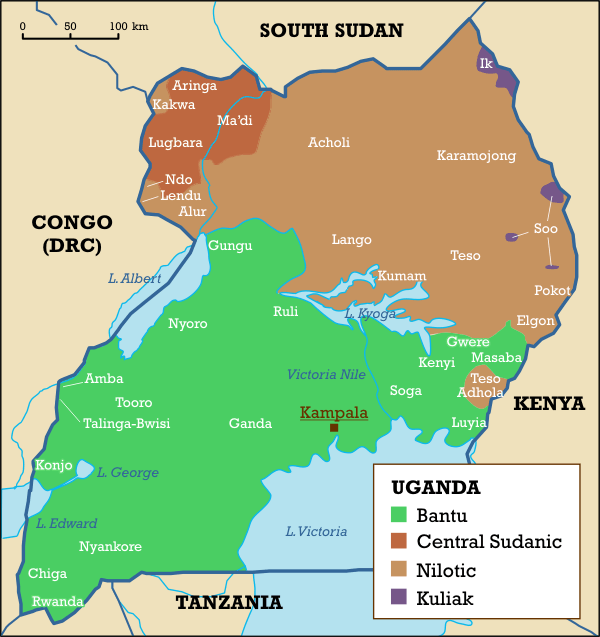
An ethnolinguistic map of Uganda
Swahili, a widely used language throughout the African Great Lakes region, was approved as the country's second official national language in 2005.[2][170] English]]was the only official language until the constitution was amended in 2005. Although Swahili has not been favoured by the Bantu-speaking populations of the south and south-west of the country, it is an important It is also widely used in the police and military forces, which may be a historical result of the disproportionate recruitment of northerners into the security forces during the colonial period. The status of Swahili has thus alternated with the political group in power.[171] For example, Idi Amin, who came from the north-west, declared Swahili to be the national language.[172]
Religion

Church in Entebbe
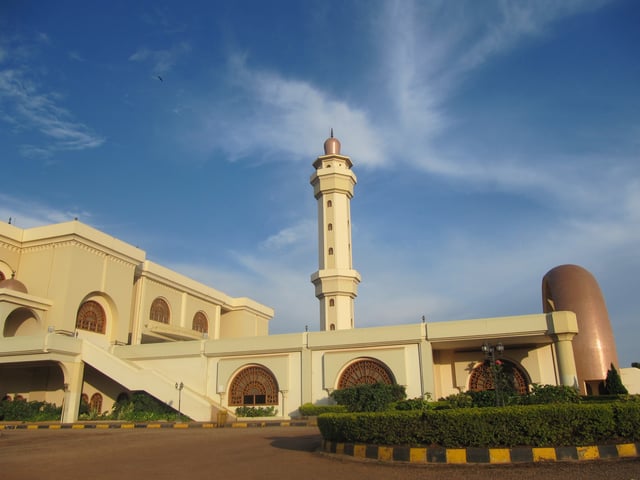
Uganda National Mosque
According to the 2014 census, Christians made up about 85 percent of Uganda's population, with Muslims making up nearly 14%.[173] The Roman Catholic Church had the largest number of adherents (39.3 percent, down from 41.6 in 2002), followed by the Anglican Church of Uganda (32 percent, down from 35.9 percent). The category of Evangelical/Pentecostal/Born-Again showed the most growth, rising from 4.7% in 2002 to 11.1% in 2018. Adventist and other Protestant churches claimed most of the remaining Christians, although there was also a small Eastern Orthodox community.[173][174] The next most reported religion of Uganda was Islam, with Muslims representing 13.7 percent of the population, up from 12.1% in 2002.[173]
The remainder of the population according to the 2014 census followed traditional religions (0.1 percent, down from 1% in 2002), other religions (1.4 percent), or had no religious affiliation (0.2 percent).[173]
Largest cities
Culture
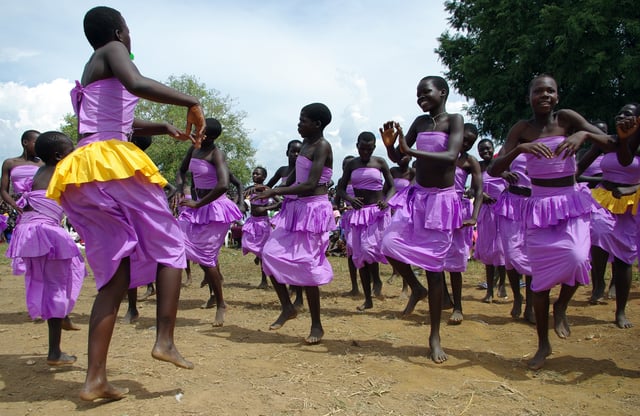
Cultural celebrations in Northern Uganda

Woman in Rwenzori – Western Uganda
Owing to the large number of communities, culture within Uganda is diverse.
Many Asians (mostly from India) who were expelled during the regime of Idi Amin have returned to Uganda.[175]
Sport
The country has an increasingly successful national basketball team. It is nicknamed "The Silverbacks,"[178] and made its debut at the 2015 FIBA Africa Championship.
In July 2011, Kampala, Uganda qualified for the 2011 Little League World Series in Williamsport, Pennsylvania for the first time, beating Saudi Arabian baseball team Dharan LL, although visa complications prevented them from attending the series.[179] Little League teams from Uganda qualified for and attended the 2012 Little League World Series.[180]
The first Olympic Gold medalist from Uganda was the 400 m hurdler Johan Akii-Bua.
At the 1972 Olympic Games in Munich, he won the 400 m hurdle race with a world record time of 47.82 seconds.[181]
Stephen Kiprotich won the men's marathon at the 2012 London Olympic Games.[182]
Cinema
The Ugandan film industry is relatively young.
It is developing quickly, but still faces an assortment of challenges.
There has been support for the industry as seen in the proliferation of film festivals such as Amakula, Pearl International Film Festival, Maisha African Film Festival and Manya Human Rights Festival. However filmmakers struggle against the competing markets from other countries on the continent such as those in Nigeria and South Africa in addition to the big budget films from Hollywood.[183]
The first publicly recognised film that was produced solely by Ugandans was Feelings Struggle, which was directed and written by Hajji Ashraf Ssemwogerere in 2005.[184] This marks the year of ascent of film in Uganda, a time where many enthusiasts were proud to classify themselves as cinematographers in varied capacities.[185]
The local film industry is polarised between two types of filmmakers.
The first are filmmakers who use the Nollywood video film era's guerrilla approach to film making, churning out a picture in around two weeks and screening it in makeshift video halls. The second is the filmmaker who has the film aesthetic, but with limited funds has to depend on the competitive scramble for donor cash.[183]
Though cinema in Uganda is evolving it still faces major challenges.
Along with technical problems such as refining acting and editing skills, there are issues regarding funding and lack of government support and investment.
There are no schools in the country dedicated to film, banks do not extend credit to film ventures, and distribution and marketing of movies remains poor.[183][185]
The Uganda Communications Commission (UCC) is preparing regulations starting in 2014 that require Ugandan television to broadcast 70 percent Ugandan content and of this, 40 percent to be independent productions.
With the emphasis on Ugandan Film and the UCC regulations favouring Ugandan productions for mainstream television, Ugandan film may become more prominent and successful in the near future.[185]
Media
See also
Index of Uganda-related articles
Outline of Uganda

